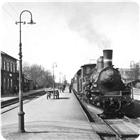The railway line

The first Danish railway was commissioned in 1847 and ran between Copenhagen and Roskilde.
Over the next 50 years, railways were laid between many of Denmark's cities and towns.
The development altered both landscape and urban environment, which were now all linked as part of a wider transport network.
In the 1870s prospecting began for the route from Næstved to Slagelse and Skælskør.
There was considerable disagreement about the route the railway would take: in fact, the argument lasted for almost 20 years.
There are several reasons for its routing here.
An efficient means of transport for goods and passengers was sought connecting the larger towns of Jutland's south west - military considerations were also important.
On 12 April 1889, King Christian IX signed the railway construction act.
The last passenger train between Dalmose and Skælskør ran in 1950 and the last train between Slagelse and Næstved ran in 1971. 1986 saw the journey of the last goods train between Slagelse and Sandved.
Photo: Dalmose Station, 1955, kindly lent by the Railway Museum.